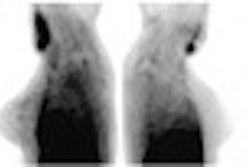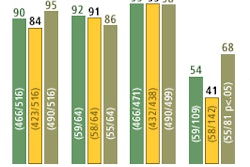BALTIMORE - Coronary artery disease patients with the most serious symptoms -- including comorbidities or past revascularization -- are more likely to wind up in the nuclear medicine imaging department. This can result in skewed referral patterns, as well as biases in patient demographics, according to a poster presentation Thursday at the American Society of Nuclear Cardiology meeting.
The study, by researchers from Duke University Medical Center in Durham, NC, suggested that referring doctors gravitate toward nuclear perfusion imaging for patients who appear to be at high risk for worsening heart disease. They followed almost 3,000 patients who had angiographically documented coronary artery disease, separating them into two cohorts based on whether or not the patient received nuclear perfusion testing.
The two groups were examined for differences in demographics, heart failure characteristics, medical histories, catheterization findings, and subsequent revascularization rates.
The results showed that angina and heart-failure symptoms were more commonly found in the group that received the nuclear testing. A greater portion had angina (p<0.001) and current heart-failure symptoms (p=0.003). These patients also were more likely to have previous revascularizations, a history of angina or heart-failure symptoms, hyperlipidemia, and carotid bruits. The nuclear medicine group was also more likely to have received angioplasty or a bypass graft in the past. Finally, the subsequent revascularization rate was 3% lower in the nuclear cohort, with a median 6-day delay before the patients underwent their procedures.
Commenting on the Duke study, Dr. Leslee Shaw, a researcher at the Atlanta Cardiovascular Research Institute, said that the bias among referring physicians is understandable, inasmuch as nuclear perfusion testing is the best way to assess whether viable heart tissue still exists.
"Any time you talk about really high-risk patients, you would hope for strategies that are very aggressive," Shaw said. "The sicker you are, the more bang for your buck. There’s a huge advantage in treating those sicker patients."
But referring only the sickest heart-failure patients could mean that other patients, who may also benefit from radionuclide perfusion studies, are getting the short end of the stick. The Duke team said its study underscored the importance of taking into account potential biases when weighing the sensitivity and specificity of the tests.
"Revascularization improved prognosis for a subset of ischemic heart-failure patients, and identification of hibernating myocardium through nuclear viability testing might aid in this differentiation," the authors wrote. "However, the referral pattern for nuclear testing likely creates significant differences in demographics and baseline clinical characteristics."
By Brian ReidAuntMinnie.com contributing writer
September 30, 2002
Related Reading
Wait time reduced with new rest-stress test protocol, September 27, 2002
GE debuts cardiac gamma camera, September 27, 2002
Late-enhancement MRI compares to FDG-PET for gauging myocardial viability, August 26, 2002
Dobutamine SPECT helps assess myocardial viability, August 19, 2002
Copyright © 2002 AuntMinnie.com



















